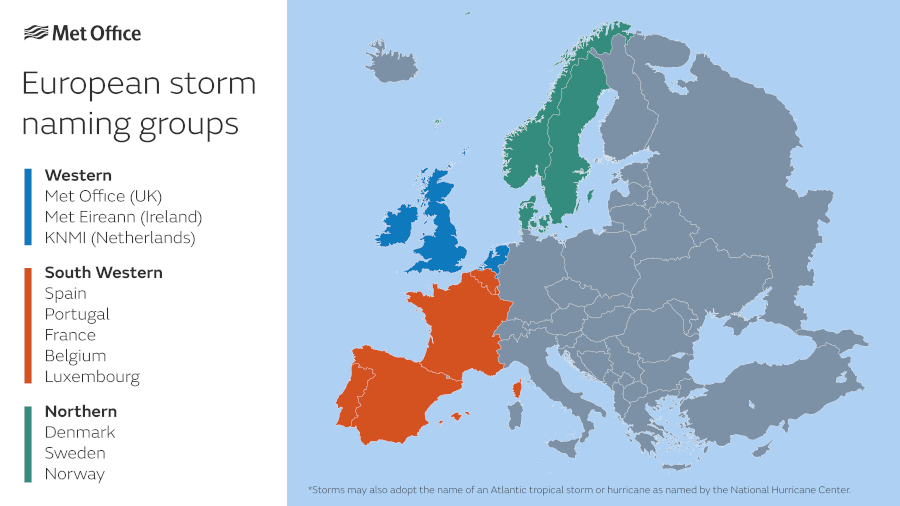UK Storm Centre
Find out the latest information about storms in the UK as we name them as part of our Name our Storms project.
Storm Names for 2023 - 2024

Throughout the year these pages will provide the latest updates and information as we name storms which we forecast will have an impact upon the UK.
| Name | Date named | Date of impact on UK and/or Ireland and/or Netherlands |
|---|---|---|
| Agnes | 25 September 2023 | 27 - 28 September 2023 |
| Babet | 16 October 2023 | 18 - 21 October 2023 |
| Ciarán | 29 October 2023 | 1 - 2 November 2023 |
| Debi | 12 November 2023 | 13 November 2023 |
| Elin | 9 December 2023 | 9 December 2023 |
| Fergus | 9 December 2023 | 10 December 2023 |
| Gerrit | 26 December 2023 | 27 - 28 December 2023 |
| Henk | 2 January 2024 | 2 January 2024 |
| Isha | 19 January 2024 | 21 - 22 January 2024 |
| Jocelyn | 22 January 2024 | 23 - 24 January 2024 |
| Kathleen | 4 April 2024 | 6 - 7 April 2024 |
| Lilian | ||
| Minnie | ||
| Nicholas | ||
| Olga | ||
| Piet | ||
| Regina | ||
| Stuart | ||
| Tamiko | ||
| Vincent | ||
| Walid |
Frequently Asked Questions
When do we announce new storm names?
Since Name our Storms first launched in 2015 we have issued a new list of names each September. The list runs from early September to late August the following year, to coincide with the start of autumn and the end of summer, when we see the likelihood of low-pressure systems and the potential for named storms increase.
Why are we naming storms?
The naming of storms using a single authoritative system provides a consistent message and aids the communication of approaching severe weather through media partners and other government agencies. In this way the public will be better placed to keep themselves, their property and businesses safe.
Can I suggest a storm name?
A new list of names will be compiled jointly between Met Éireann, the Met Office and KNMI (The Dutch national weather forecasting service).
Everyone is welcome to suggest names for future consideration via email to [email protected] or through our online form. Any future names for the Met Office component of the list may be compiled from these suggestions.
When is a storm named?
In the UK a storm will be named when it has the potential to cause disruption or damage which could result in an amber or red warning. This is based on our National Severe Weather Warnings service, which is a combination of both the impact the weather may have, and the likelihood of those impacts occurring.
Storms will usually be named on the basis of the impacts from strong winds, but the impacts of other weather types will also be considered. For example rain, if its impact could lead to flooding as advised by the Environment Agency, SEPA and Natural Resources Wales flood warnings, or snow. Therefore 'storm systems' could be named on the basis of impacts from the wind but also include the impacts of rain and snow.
How is a storm named?
When the criteria for naming a storm are met, either the Met Office, Met Éireann or KNMI can name a storm, taking the name from the latest list in alphabetical order.
We then let the public, our partners in government, the responder community and the media know through various routes including publishing details on our website and social media channels.
You can also follow the Met Office on Facebook or Twitter for the latest updates.
UK and US Storm names?
To avoid any confusion over naming, if a storm is the remnants of a tropical storm or hurricane that has moved across the Atlantic, the name would not be changed and would follow the established method of being referred to as 'ex-hurricane Ophelia' for example.
We will only use names that have been officially designated by the National Weather Service in the US.
Do other countries around the world use a similar system?
In Europe, the UK, Ireland and the Netherlands work together as the western storm naming group. Spain, Portugal, France, Belgium and Luxembourg together make up the south-western storm naming group and Norway, Sweden and Denmark are the northern group.

Within the North Atlantic Ocean, tropical or subtropical cyclones are named by the National Hurricane Centre when they are judged to have intensified into a tropical storm with winds of at least 65 km/h, (40 mph). The World Meteorological Organisation maintains six alphabetical lists of names which alternate between masculine and feminine and are used on a six-year cycle. Significant tropical cyclones have their names retired from the lists, with a replacement name selected at the next World Meteorological Organisation (WMO) meeting.
Why are there no storms for Q, U, X, Y and Z?
To ensure we are in line with the US National Hurricane Centre naming conventions, we are not going to include names which begin with the letters Q, U, X, Y and Z. This will maintain consistency for official storm naming in the North Atlantic.
How are storm names chosen?
We receive thousands of suggestions throughout the year from the public and this years list has been compiled from these public suggestions, plus suggestions from Met Éireann and KNMI, choosing some of the more popular names and names that reflect the diversity of the UK, Ireland and the Netherlands.
What does climate change mean for storms?
In the recent climate, there is no evidence of positive or negative trends in windstorm number or intensity. Trends in windstorm numbers are difficult to detect, due to how these naturally vary year-to-year and decade-to-decade.


